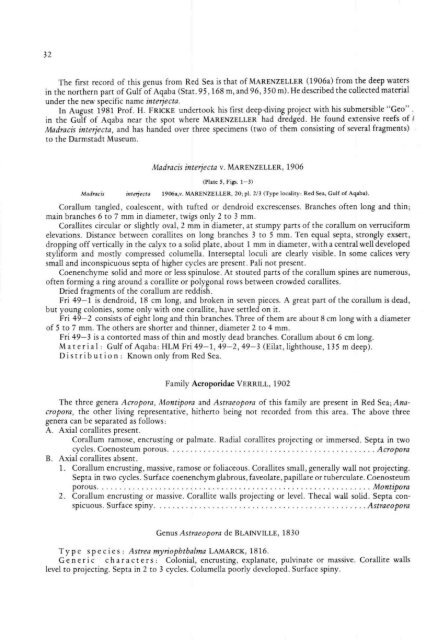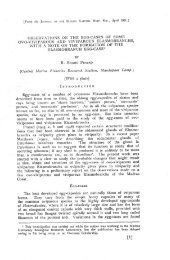PDF - Eprints@CMFRI
PDF - Eprints@CMFRI
PDF - Eprints@CMFRI
Create successful ePaper yourself
Turn your PDF publications into a flip-book with our unique Google optimized e-Paper software.
32<br />
The first record of this genus from Red Sea is that of MARENZELLER (1906a) from the deep waters<br />
in the northern part of Gulf of Aqaba (Stat. 95, 168 m, and 96,350 m). He descrIbed the collected matenal<br />
under the new specific name interjecta.<br />
In August 1981 Prof. H. FRICKE undertook his first deep-diving project with his submersible " Geo" .<br />
in the Gulf of Aqaba near the spot where MARENZELLER had dredged . He fo und extensive reefs of I<br />
Madracis interjecta, and has handed over three specimens (two of them consist ing of several fragments)<br />
to the Darmstadt Museum.<br />
Madracis interjecta v. MAR EN ZELLE R, 1906<br />
(Plate 5, Figs. 1- 3)<br />
Madracis intf!1jt!CllJ 1906a,v. MARENZELLER, 20; pI. 2/3 (Type locality: Red Sea, Gulf of Aqaba).<br />
Corallum tangled , coalescent , with tufted or dendroid excrescenses. Branches oft en long and thin;<br />
main branches 6 to 7 mm in diameter, twigs only 2 to 3 mm.<br />
Corallites circular or slightly oval, 2 mm in diameter, at stumpy parts of the corallum on verruciform<br />
elevations . Distance between corallites on long branches 3 to 5 mm. Ten equal septa, strongly exsert,<br />
dropping off vertically in the calyx to a solid plate, about 1 mm in diameter, with a central well developed<br />
styliform and mostly compressed columella. Interseptal loculi are clearly visible. In so me calices very<br />
small and inconspicuous septa of higher cycles are present. Pali not present.<br />
Coenenchyme solid and more or less spinulose. At stouted parts of the corallum spines are numerous,<br />
often forming a ring around a corallite or polygonal rows between crowded corallites.<br />
Dried fragments of the corallum are reddish .<br />
Fri 49-1 is dendroid, 18 em long, and broken in seven pieces. A great part of the corallum is dead ,<br />
but young colonies, some only with one corallite, have settled on it.<br />
Fri 49- 2 consists of eight long and thin branches. Three of them are about 8 em long with a diameter<br />
of 5 to 7 mm. The others are shorter and thinner, diameter 2 to 4 mm.<br />
Fri 49- 3 is a contorted mass of thin and mostly dead branches. Corallum about 6 em long.<br />
M a t e ri a I : Gulf of Aqaba: HLM Fri 49-1, 49- 2, 49- 3 (Eilat , lighthouse, 135m deep).<br />
D is t ri b u ti 0 n : Known only from Red Sea.<br />
Family Acroporidae VERRILL, 1902<br />
The three ge nera Acropora, Montipora and Astraeopora of this family are present in Red Sea; Anacropora,<br />
the other living representative, hitherto being not recorded from this area. The above three<br />
genera can be separated as follows:<br />
A. Axial corallites present.<br />
Corallum ramose, encrusting or palmate. Radial corallites projecting or immersed . Septa in two<br />
cycles. Coenosteum porous . .. ..... .. ....... .. .... . . _ ..... .. ........... .. . Acropora<br />
B. Axial corallites absent.<br />
1. Corall um encrusting , massive, ramose or foliaceous. Corallites small, ge nera lly wall not projecting.<br />
Septa in two cycles. Surface coenenchym glabrous, faveolate , papillate or tuberculate. Coenosteum<br />
porous . . . . . . . ................................. . ................ . .. . . Montipora<br />
2. Corallum encrusting or massive. Corallite walls projecting or level. Thecal wall solid. Septa conspicuous.<br />
Surface spiny . ... . _ . . ... . . . . . . .... . . . .. ... . . .... . .... .. . . . _ .. Astraeopora<br />
Genus Astraeopora de BLAINVILLE, 1830<br />
Type s p ecies: Astrea myriopbtbalma LAMARCK , 1816.<br />
G e n e ric c h a r ac t e r s : Colonial, encrust ing, explanate, pulvinate or massive. Corallite walls<br />
level to projecting. Septa in 2 to 3 cycles. Columella poorly developed . Surface spiny.
















